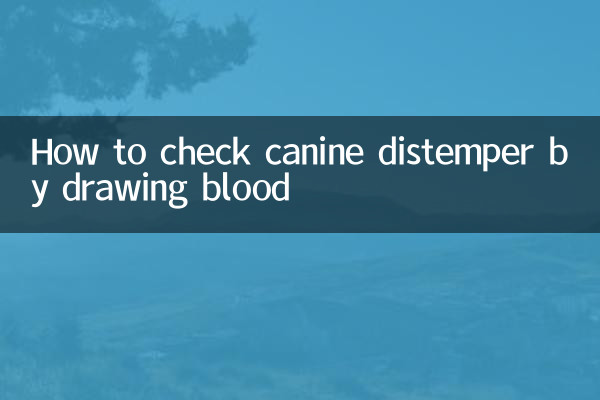How to check canine distemper by drawing blood
Canine distemper is an infectious disease that is extremely harmful to dogs, and early diagnosis and treatment are crucial. Blood examination is one of the important methods for diagnosing canine distemper. This article will introduce in detail the relevant content of canine distemper blood test, including inspection items, procedures, precautions, etc., and attach structured data for reference.
1. Common items of canine distemper blood test

Blood tests mainly determine whether a dog is infected with canine distemper by detecting antibodies, viral nucleic acids or routine blood indicators in the blood. The following are common inspection items:
| Check items | Detection content | meaning |
|---|---|---|
| Canine distemper antibody test | IgM, IgG antibodies | Determine whether there is infection or vaccination effect |
| PCR test | viral nucleic acid | Detect viruses directly to confirm infection |
| Routine blood tests | White blood cells, lymphocytes, etc. | Assess immune system and level of infection |
| Biochemical examination | Liver function, kidney function, etc. | Assess whether organ function is impaired |
2. The process of blood test for canine distemper
1.Make an appointment for inspection: Contact the pet hospital in advance, explain the dog’s symptoms and needs, and make an appointment for blood drawing.
2.Preoperative preparation: Fasting 8-12 hours before the examination (according to doctor's advice) and avoiding strenuous exercise.
3.Blood drawing operation: Doctors usually take a small sample of blood from a vein in your dog's forelimb or jugular vein.
4.Sample submission: Blood samples will be sent to the laboratory for testing, and results will usually be available in 1-3 days.
5.Interpretation of results: The veterinarian will give diagnosis and treatment suggestions based on the test results and clinical symptoms.
| Process steps | time requirement | Things to note |
|---|---|---|
| Make an appointment for inspection | 1 day in advance | Explain your dog’s symptoms and medical history |
| Preoperative preparation | 8-12 hours before inspection | Fasting but allowed to drink water |
| Blood drawing operation | About 5-10 minutes | Soothe your dog’s mood |
| Sample testing | 1-3 days | Depends on the test items |
3. Precautions for blood examination for canine distemper
1.Check timing: If you have suspected symptoms (such as fever, eye and nose secretions, cough, etc.), you should get checked as soon as possible.
2.fasting requirements: Usually you need to fast for 8-12 hours, but you can drink water, and follow the doctor's advice.
3.Soothe the dog: The owner should be present to comfort the patient during blood drawing, and sedatives can be used if necessary (as determined by the doctor).
4.Interpretation of results: Antibody testing needs to distinguish whether it is caused by infection or vaccine, and it needs to be combined with other tests to make a comprehensive judgment.
5.cost estimate: The fees for different examination items vary greatly, so you can consult the hospital in advance.
| Things to note | Detailed description |
|---|---|
| Check timing | The detection rate is high in the early stages of symptoms, but antibodies may have declined in the late stages |
| fasting requirements | Avoid hyperlipidemia from affecting some test results |
| Sample quality | Hemolyzed samples may affect test accuracy |
| comprehensive diagnosis | Need to be combined with clinical symptoms and other examination results |
4. Cost reference for canine distemper blood test
The cost of canine distemper related examinations varies depending on the region, hospital level and testing items. The following is an approximate cost reference:
| Check items | Cost range (yuan) | Remarks |
|---|---|---|
| Canine distemper antibody test | 150-300 | Single test |
| PCR test | 200-500 | gold standard for diagnosis |
| Routine blood tests | 80-150 | basic check |
| Full set of inspections | 500-1000 | Contains multiple tests |
5. Prevention and care of canine distemper
1.Vaccination: Regular vaccination against canine distemper is the most effective preventive measure.
2.quarantine measures: Dogs diagnosed with canine distemper should be strictly isolated to avoid infecting other dogs.
3.Environmental disinfection: Use special disinfectant to clean the dog’s living area.
4.nutritional support: Provide easy-to-digest, highly nutritious food during illness.
5.Seek medical attention promptly: Seek medical attention immediately once suspected symptoms are discovered. Early treatment has a higher success rate.
Canine distemper is a serious infectious disease, but with scientific detection and timely treatment, many dogs can recover. As an owner, understanding the relevant knowledge of canine distemper blood tests can help you take better care of your dog and make the right decisions at critical moments.

check the details

check the details